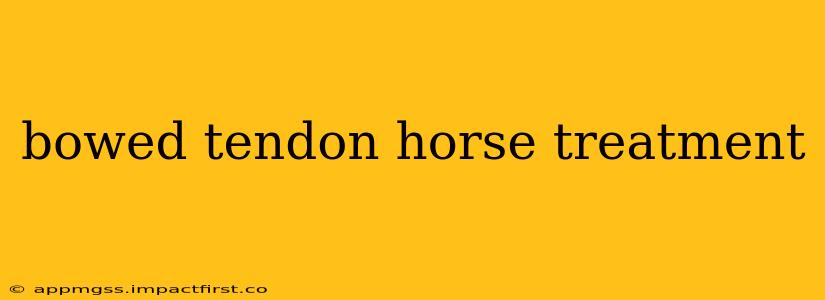A bowed tendon, formally known as a flexor tendon injury, is a serious and debilitating injury in horses. It involves damage to one or more of the tendons that run down the back of the leg, causing swelling and a characteristic bowing of the leg. This condition can significantly impact a horse's athletic performance and even their ability to walk comfortably. Understanding the treatment, recovery process, and preventative measures is crucial for horse owners and equine professionals.
What Causes a Bowed Tendon in Horses?
Bowed tendons most commonly result from overexertion or repetitive stress on the tendons. This can occur during intense training, strenuous exercise, or even from landing awkwardly after a jump. Factors contributing to the risk include:
- High-impact activities: Jumping, racing, and eventing significantly increase the risk.
- Poor conditioning: Horses that are not properly conditioned are more susceptible to injury.
- Inadequate hoof care: Improper trimming and shoeing can affect the biomechanics of the leg, increasing stress on the tendons.
- Underlying conditions: Certain pre-existing conditions, such as bone chips or joint problems, can predispose a horse to bowed tendons.
How is a Bowed Tendon in Horses Diagnosed?
Diagnosis typically involves a thorough physical examination by a veterinarian. They will assess the horse's gait, palpate the affected leg for swelling and heat, and may utilize imaging techniques such as ultrasound or MRI to determine the severity of the injury. Ultrasound is commonly used to visualize the extent of tendon damage.
What are the different grades of bowed tendon?
The severity of a bowed tendon is often graded, usually on a scale of 1 to 4, with grade 1 being a minor injury and grade 4 being a severe tear. This grading system helps veterinarians determine the appropriate treatment plan.
Bowed Tendon Treatment in Horses: What are the options?
Treatment for bowed tendons varies greatly depending on the severity of the injury and the individual horse. Options may include:
- Rest and stall confinement: This is crucial in the initial stages to allow the tendon to heal. The duration of rest will depend on the severity of the injury.
- Cold therapy: Applying ice packs to the affected area helps reduce swelling and inflammation.
- Bandaging and support: Bandages can help provide support and minimize further injury.
- Anti-inflammatory medication: Non-steroidal anti-inflammatory drugs (NSAIDs) may be prescribed to reduce pain and inflammation.
- Controlled exercise: Once the initial inflammation subsides, controlled exercise may be introduced under veterinary supervision to promote healing and prevent stiffness.
- Shockwave therapy: This involves using sound waves to stimulate healing in the tendon.
- Interferon therapy: This treatment involves injecting interferon into the tendon to reduce inflammation and promote healing.
- Surgery: In severe cases with complete tendon rupture, surgery may be necessary to repair the tendon.
How long does it take for a bowed tendon to heal?
The recovery time for a bowed tendon varies significantly based on the severity of the injury and the individual horse's response to treatment. It can range from several months to over a year. Patience and diligent adherence to the veterinarian's recommendations are crucial for successful recovery.
What is the prognosis for a horse with a bowed tendon?
The prognosis for a horse with a bowed tendon depends on several factors, including the severity of the injury, the horse's age and overall health, and the quality of care received. Many horses make a full recovery and return to their previous level of athletic performance, while others may experience some degree of residual lameness.
Bowed Tendon Prevention in Horses: How can I help prevent this?
Preventing bowed tendons involves a multifaceted approach:
- Proper conditioning: Gradually increase the intensity and duration of exercise to avoid overexertion.
- Consistent hoof care: Regular trimming and shoeing by a qualified farrier help maintain proper leg biomechanics.
- Appropriate surfaces: Training on well-maintained surfaces reduces the risk of injury.
- Supplementation: Some supplements, such as those containing glucosamine and chondroitin, may help support tendon health.
Disclaimer: This information is for educational purposes only and should not be considered veterinary advice. Always consult with a qualified veterinarian for any concerns regarding your horse's health. Early detection and prompt treatment are essential for optimizing the outcome of a bowed tendon injury.
